DCR-18380Z Single Wire and Cable Vertical Burning Tester - Reliable
Introduction to Advanced Cable Fire Safety Testing
In critical infrastructure, industrial applications, and commercial buildings, the fire safety performance of wires and cables is paramount. Failure to meet stringent flammability standards can lead to catastrophic damage, loss of life, and significant economic repercussions. To address these critical safety requirements, manufacturers, R&D facilities, and certification bodies rely on highly specialized testing equipment. The DCR-18380Z Single Wire and Cable Vertical Burning Tester stands as a cornerstone in this vital sector, providing a precise, repeatable, and compliant platform for evaluating the vertical flame propagation characteristics of single insulated wires and cables.
This advanced instrument is engineered to simulate specific fire conditions, enabling a thorough assessment of a cable's ability to resist flame spread and self-extinguish. Its design and functionality are critical for ensuring that electrical and data transmission infrastructure adheres to international safety standards, thereby mitigating fire risks across a multitude of industries.
Industry Trends in Wire & Cable Fire Safety and Testing
The landscape of wire and cable fire safety is continually evolving, driven by several key trends:
- Stricter Regulatory Frameworks: Globally, regulatory bodies are mandating increasingly rigorous fire safety standards. For instance, the IEC 60332 series for vertical flame propagation and UL 1581 for vertical tray flame tests are being continuously updated and enforced, pushing manufacturers towards higher performance materials and more robust testing protocols. This trend is particularly evident in public buildings, transportation, and critical infrastructure projects where fire risks are amplified.
- Emergence of Advanced Flame-Retardant Materials: Innovations in polymer science have led to the development of new flame-retardant (FR) and low-smoke zero-halogen (LSZH) compounds. These materials significantly reduce smoke density, corrosive gas emission, and flame propagation, offering enhanced safety. However, verifying the efficacy of these new materials necessitates highly accurate and repeatable testing equipment like the DCR-18380Z Single Wire and Cable Vertical Burning Tester.
- Increased Demand for Data and Automation: Modern testing labs require not just pass/fail results but comprehensive data logging, analysis, and report generation. The trend is towards automated testing processes that minimize human error, improve throughput, and provide granular insights into material behavior under fire conditions.
- Focus on Sustainability and Environmental Impact: Beyond fire safety, there's a growing emphasis on environmentally friendly cable materials and manufacturing processes. This includes exploring halogen-free alternatives and ensuring that testing methods align with sustainable practices.
- Global Harmonization of Standards: While regional standards persist, there's a movement towards harmonizing international testing methodologies to facilitate global trade and ensure consistent safety levels worldwide. Testers that comply with multiple international standards offer significant advantages to global manufacturers.
These trends collectively underscore the critical need for sophisticated and reliable testing apparatus. The DCR-18380Z Single Wire and Cable Vertical Burning Tester is specifically designed to meet these evolving demands, offering the precision and compliance necessary for the modern wire and cable industry.
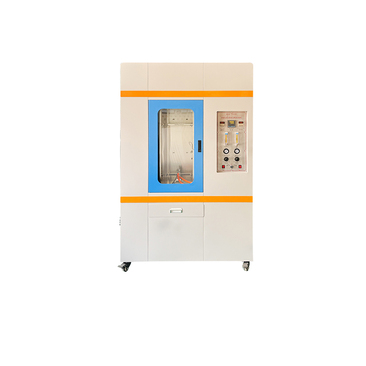
Manufacturing Process and Quality Assurance of the DCR-18380Z Tester
The construction of the DCR-18380Z Single Wire and Cable Vertical Burning Tester is a testament to precision engineering and robust material selection, ensuring its long-term reliability and accuracy. The meticulous process involves several critical stages, each governed by stringent quality control protocols.
1. Product Materials Selection:
- Test Chamber: Constructed from high-grade stainless steel (e.g., SUS304 or SUS316, depending on corrosive environment resistance needs). This material offers superior corrosion resistance, high-temperature stability, and ease of cleaning, ensuring structural integrity over years of exposure to combustion byproducts.
- Burner Assembly: Utilizes a precisely machined brass or stainless steel burner (e.g., Tirrill or Bunsen type, depending on standard requirements) with specific orifice dimensions. High-quality gas flow meters and pressure regulators ensure consistent and accurate flame application.
- Control System: Incorporates industrial-grade Programmable Logic Controllers (PLCs), high-resolution touchscreens, precise thermocouples (K-type or equivalent for temperature monitoring), and durable electrical components. Wiring adheres to IEC standards for industrial equipment.
- Exterior Casing: Often a robust steel frame with high-quality powder coating, providing durability and a professional finish while protecting internal components.
2. Advanced Manufacturing Processes:
- Precision Sheet Metal Fabrication: Automated laser cutting and CNC bending technologies are employed to create the exact dimensions of the test chamber components, ensuring minimal tolerances and perfect fitment.
- Welding & Assembly: Critical joints in the stainless steel chamber are often argon-arc welded (TIG welding) to ensure robust, leak-proof, and corrosion-resistant seams. Subsequent assembly involves skilled technicians carefully integrating mechanical and electrical subsystems.
- CNC Machining: Components like the burner head, gas flow regulators, and specific mounting brackets undergo CNC machining for micron-level precision, crucial for repeatable flame characteristics and specimen positioning.
- Calibration & Testing: Each unit undergoes multi-stage calibration. This includes gas flow calibration against certified standards, timing accuracy validation, and temperature sensor calibration. Full functional tests are performed to ensure compliance with relevant standards (e.g., IEC 60332-1-2).
3. Quality Control and Testing Standards (for the Tester):
Our manufacturing process adheres to internationally recognized quality management systems, notably ISO 9001, which ensures consistent product quality from design to delivery. Furthermore, internal testing facilities are equipped to calibrate components to standards like ISO/IEC 17025, guaranteeing the accuracy and traceability of measurements.
4. Service Life and Target Industries:
Designed for longevity, the DCR-18380Z Single Wire and Cable Vertical Burning Tester boasts an estimated service life exceeding 10 years with proper maintenance, thanks to its robust construction and high-quality components. It serves a broad spectrum of industries where wire and cable fire safety is paramount:
- Petrochemical Industry: Ensuring cables in refineries and chemical plants resist ignition and flame spread in hazardous environments.
- Electrical Utilities & Power Generation: Verifying insulation and jacket materials for power transmission and distribution cables, including those in nuclear power plants.
- Building & Construction: Compliance testing for cables used in residential, commercial, and industrial buildings to meet fire codes.
- Telecommunications: Assessing data and communication cables for server farms, data centers, and network infrastructure.
- Automotive & Rail: Testing specialized cables for vehicle and railway systems where fire safety is a critical design parameter.
5. Advantages in Typical Application Scenarios:
- Energy Saving: While the tester itself consumes energy, its accurate and repeatable results enable manufacturers to optimize cable formulations, potentially leading to the development of more energy-efficient and safer materials that prevent fire-related energy losses.
- Corrosion Resistance: The use of stainless steel in critical areas of the tester ensures longevity and consistent performance even when exposed to corrosive byproducts of certain cable materials during testing, reducing maintenance and replacement costs.
- Enhanced Safety (for Tester Operation): Integrated exhaust systems and safety interlocks protect lab personnel from harmful fumes and accidental exposure to flame, aligning with modern industrial safety practices.
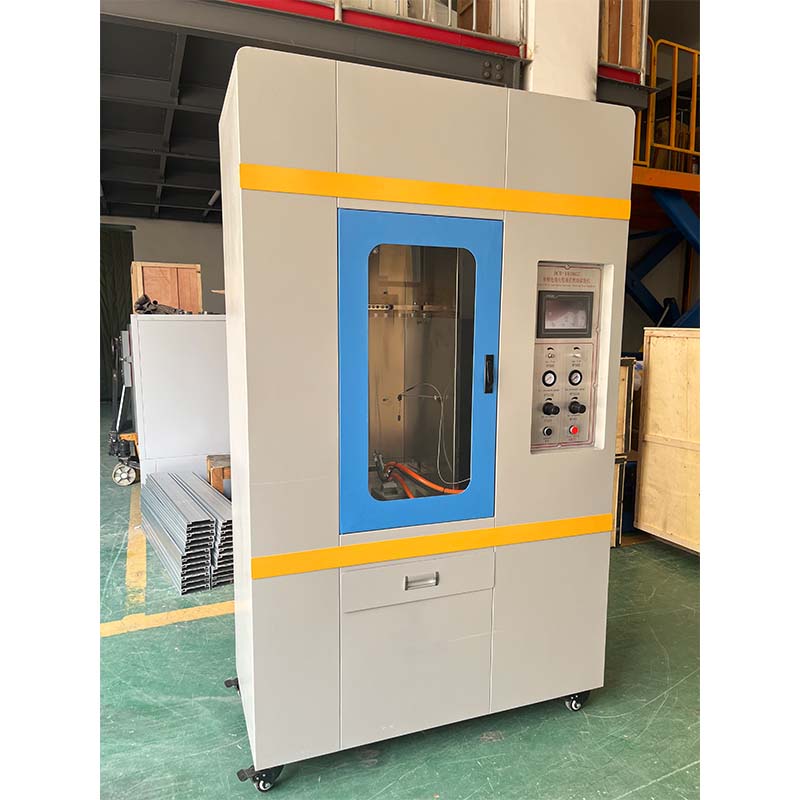
Technical Specifications and Parameters
The DCR-18380Z Single Wire and Cable Vertical Burning Tester is engineered to deliver highly accurate and reproducible results, conforming to a range of international standards. Below are its key technical specifications, crucial for understanding its capabilities and ensuring precise testing.
Product Specification Table: DCR-18380Z Single Wire and Cable Vertical Burning Tester
| Parameter | Specification |
|---|---|
| Test Standard Compliance | IEC 60332-1-2 (equivalent to EN 50265-2-1), GB/T 18380.11, VDE 0482-332-1-2, UL 1581 (specific sections), ISO 17846 |
| Burner Type | Standard Tirrill or Bunsen burner, with specific dimensions and air/gas mixture control as per standard. |
| Flame Application Time | Adjustable, typically 1s, 5s, 10s, 20s, 30s, 60s, 120s; controlled by PLC. |
| Test Chamber Volume | Typically >0.5 m³ (e.g., 300mm x 300mm x 1200mm internal dimensions), with robust exhaust system. |
| Gas Type | Industrial-grade Propane or Methane (LPG with specific purity). Regulated by mass flow controller for precision. |
| Gas Flow Control | High-precision mass flow controller (MFC) for accurate regulation of gas and air mixture. Digital display. |
| Control System | PLC-based with 7-inch color touchscreen HMI. Automated ignition, timing, and data logging. |
| Safety Features | Automatic gas shut-off, emergency stop button, exhaust fan interlock, flame monitoring sensor. |
| Data Output | Digital display of afterflame time, afterglow time, char length (manual measurement assisted), USB data export. |
| Dimensions (Approx.) | W 600mm x D 700mm x H 1500mm (including exhaust fan) |
| Power Supply | AC 220V, 50/60Hz, 10A (or local equivalent) |
| Construction Material | Stainless steel internal chamber, powder-coated steel frame. |
Key Parameters Explained:
- Afterflame Time: The duration for which the specimen continues to flame after the burner flame is removed. A shorter afterflame time indicates better flame retardancy.
- Afterglow Time: The duration for which the specimen continues to glow after the flame has ceased. This measures residual combustion.
- Char Length: The length of the damaged portion of the cable after the test. This provides a visual and measurable indication of flame propagation extent.
- Ignition Source: The specific flame type and size (e.g., a 1 kW flame as per IEC 60332-1-2) produced by the burner, precisely controlled for consistency.
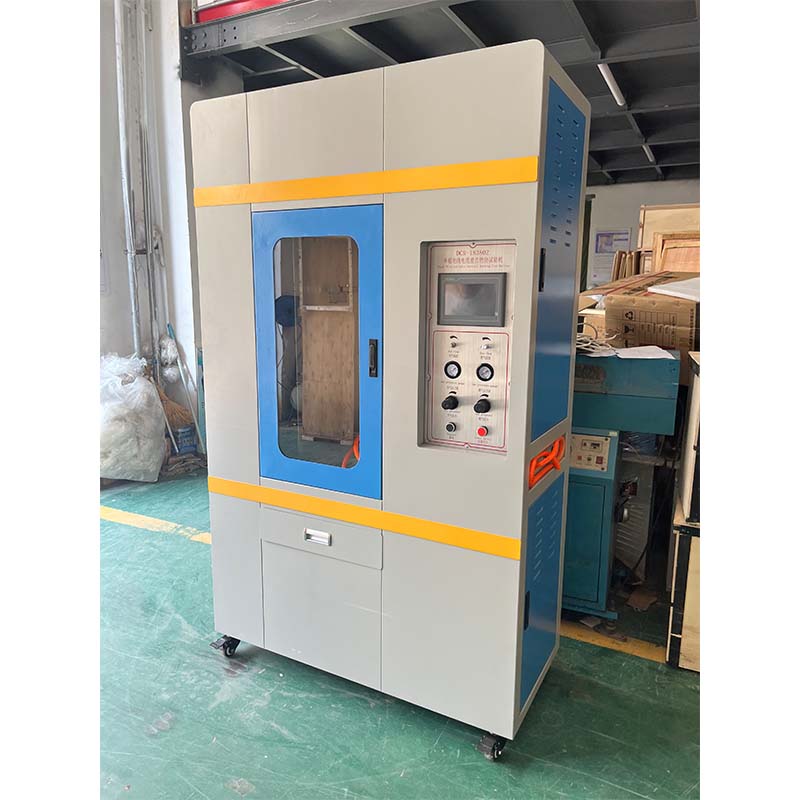
Application Scenarios and Operational Experience
The versatility and precision of the DCR-18380Z Single Wire and Cable Vertical Burning Tester make it an indispensable tool across numerous industrial and research applications. Its robust design and adherence to international standards ensure reliable performance in demanding environments.
Key Usage Scenarios:
- Cable Manufacturing Quality Control: Manufacturers integrate the DCR-18380Z into their production lines to perform routine batch testing of finished cables and raw insulation materials. This ensures that every product leaving the factory meets the specified flame retardancy requirements before distribution.
- Research & Development of Flame-Retardant Materials: Material scientists and polymer engineers utilize the tester to evaluate new flame-retardant additives, halogen-free compounds, and improved jacket formulations. The precise data on afterflame and afterglow times allows for rapid iteration and optimization of material properties.
- Third-Party Certification and Testing Laboratories: Independent labs offering certification services for various industries rely on the DCR-18380Z for unbiased, accredited testing. Its compliance with IEC, UL, and other major standards makes it suitable for issuing official test reports essential for market entry and regulatory approval.
- Procurement and Incoming Material Inspection: Large-scale infrastructure projects, such as power plants, railway systems, and telecommunication networks, use the tester to verify that incoming cable shipments meet contractual fire safety specifications, preventing non-compliant materials from being installed.
- Educational and Training Institutions: Universities and vocational training centers employ the DCR-18380Z for practical demonstrations and research in fire safety engineering, providing students with hands-on experience in essential material characterization techniques.
Operational Experience and Customer Feedback:
Our clients consistently report exceptional operational experience with the DCR-18380Z. For instance, a leading electrical utility provider noted that integrating the DCR-18380Z Single Wire and Cable Vertical Burning Tester into their procurement vetting process significantly reduced the risk of using non-compliant cables in critical grid infrastructure, directly enhancing system reliability and public safety. Similarly, a petrochemical firm emphasized how the tester's robust data logging capabilities enabled them to demonstrate stringent material compliance to regulators, streamlining project approvals.
Users commend its intuitive touchscreen interface, which minimizes training time and reduces the potential for operational errors. The automated gas flow control and precise timing mechanisms ensure high repeatability, a critical factor for comparative studies and long-term quality assurance programs. The clear, concise reporting functions aid in swift decision-making and efficient record-keeping, essential for maintaining rigorous quality control documentation.
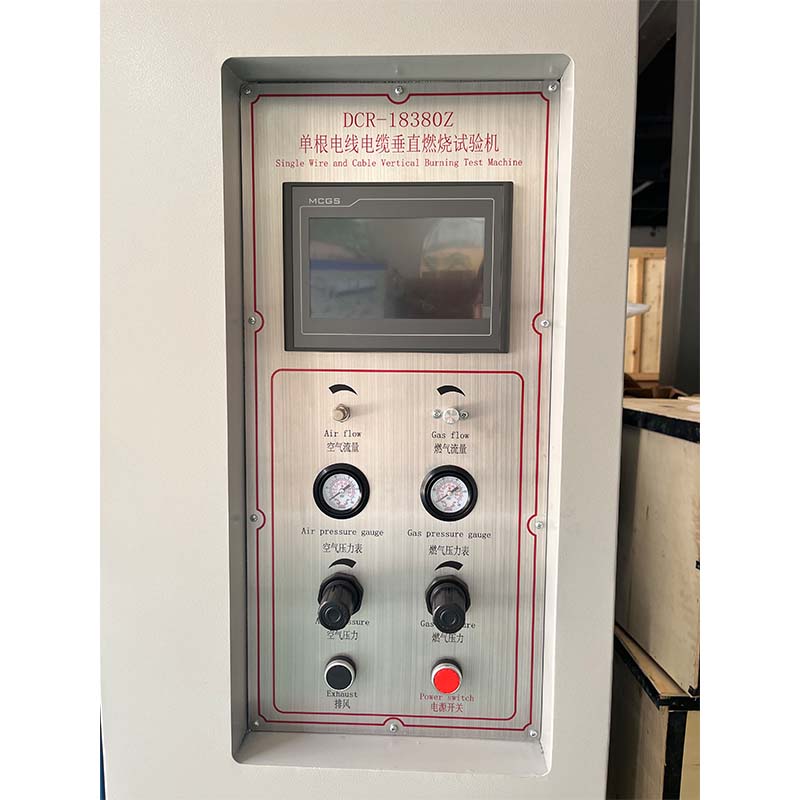
Technical Advantages of DCR-18380Z
The DCR-18380Z Single Wire and Cable Vertical Burning Tester distinguishes itself through a suite of advanced technical features designed to maximize accuracy, safety, and operational efficiency, making it a preferred choice for demanding fire safety testing applications.
- Unparalleled Precision and Repeatability: At its core, the DCR-18380Z incorporates a highly stable gas supply system with mass flow controllers (MFCs) for both air and gas. This ensures an exact and consistent flame calibration (e.g., 1 kW flame for IEC 60332-1-2), crucial for repeatable test conditions. Digital timers with millisecond accuracy precisely record afterflame and afterglow times, reducing measurement variability significantly.
- Advanced Automation and Digital Control: Equipped with a robust PLC-based control system and an intuitive touchscreen HMI, the tester offers automated ignition, precise flame application timing, and automatic burner retraction. This automation minimizes operator influence, enhances test consistency, and allows for programmable test sequences tailored to various standards.
- Comprehensive Safety Features: Operator safety is paramount. The unit includes an integrated exhaust fan to remove combustion byproducts, automatic gas shut-off in case of power failure or emergency, and a prominent emergency stop button. Flame monitoring sensors detect unintended flame presence, further enhancing operational security.
- Broad Standard Compliance: The DCR-18380Z is meticulously designed to comply with a wide array of international fire safety standards, including IEC 60332-1-2 (Methods of test on vertical flame spread of a single vertical insulated wire or cable), GB/T 18380.11, VDE 0482-332-1-2, and relevant sections of UL 1581. This multi-standard compliance makes it a versatile asset for global manufacturers and testing labs.
- User-Friendly Interface and Data Management: The large color touchscreen provides real-time data display, easy parameter adjustments, and clear visual feedback. Test results, including afterflame and afterglow times, are automatically logged and can be exported via USB, facilitating detailed analysis, reporting, and archiving in compliance with ISO/IEC 17025 requirements.
- Durable and Corrosion-Resistant Construction: The test chamber is constructed from high-quality stainless steel, ensuring long-term resistance to heat, corrosive fumes, and wear. This robust build quality contributes to an extended service life and consistent performance, even under heavy operational cycles.
Vendor Comparison: DCR-18380Z vs. Market Alternatives
When investing in critical fire safety testing equipment, a thorough comparison of available options is essential. The DCR-18380Z Single Wire and Cable Vertical Burning Tester offers distinct advantages over many conventional and even some advanced market alternatives. This comparison highlights key differentiating factors.
Product Comparison Table: Vertical Burning Testers
| Feature/Parameter | DCR-18380Z | Generic Competitor A (Basic) | Generic Competitor B (Advanced) |
|---|---|---|---|
| Standard Compliance | IEC 60332-1-2, GB/T 18380.11, UL 1581 (sections), ISO 17846 | IEC 60332-1-2 (basic) | IEC 60332-1-2, some UL standards |
| Burner Control | Automated with Mass Flow Controller (MFC) for precise gas/air mixture. | Manual knob adjustment for gas, basic pressure gauge. | Digital flowmeters, but may lack MFC precision. |
| Control Interface | 7-inch Color Touchscreen HMI, PLC-based. | Push buttons, LED display, analog timers. | Smaller monochrome LCD, basic digital controls. |
| Data Logging & Export | Automatic data logging, USB export, customizable reports. | Manual recording only. | Limited internal storage, basic serial port output. |
| Safety Features | Auto gas shut-off, E-stop, exhaust interlock, flame sensor. | Manual gas valve, simple E-stop. | Gas shut-off, E-stop, but may lack flame sensor. |
| Chamber Material | High-grade Stainless Steel (SUS304/316). | Painted mild steel or lower grade stainless. | Stainless steel, but possibly thinner gauge. |
| After-Sales Support | Global network, comprehensive training, spare parts, remote/on-site support. | Limited, often regional. | Moderate, primarily through distributors. |
| Price Point (Qualitative) | Mid-to-High (Value for advanced features and compliance). | Low (Basic functionality, minimal automation). | Mid (Some advanced features, but may lack DCR-18380Z's full package). |
As illustrated, the DCR-18380Z provides a compelling balance of advanced features, robust construction, comprehensive standard compliance, and superior user experience. While basic models may offer a lower initial cost, they often compromise on precision, automation, and long-term reliability, leading to higher operational costs and potential compliance issues. Advanced competitors may match some of DCR-18380Z's features but often fall short in combining its full suite of capabilities, particularly in the realm of highly precise gas control, intuitive HMI, and extensive after-sales support.

Customized Solutions and Enhanced Capabilities
Understanding that standard solutions may not always perfectly align with every client's unique operational workflows or specialized research needs, we offer bespoke customization options for the DCR-18380Z Single Wire and Cable Vertical Burning Tester. Our engineering team collaborates closely with clients to tailor the instrument for specific requirements, enhancing its utility and integration within existing laboratory infrastructures.
Potential Customization Options Include:
- Expanded Data Acquisition and Reporting: Beyond standard afterflame/afterglow timing, we can integrate additional sensors for real-time smoke density measurement, temperature profiles within the chamber, or gas analysis for specific combustion byproducts. Custom software modules can generate reports tailored to client-specific formats or regulatory submission requirements.
- Integration with Laboratory Information Management Systems (LIMS): For large-scale testing facilities, seamless integration with LIMS is crucial for streamlined data flow and reduced manual entry errors. We can develop API connectors or specific data output formats to ensure compatibility with existing LIMS platforms.
- Specialized Burner Configurations: While the standard burner meets most compliance needs, specific research applications might require alternative burner designs or specialized gas mixtures. Our team can explore and implement these modifications, ensuring precise flame characteristics for unique test protocols.
- Enhanced Environmental Controls: For highly sensitive material testing, integrating environmental controls such as precise temperature and humidity regulation within a pre-conditioning chamber adjacent to the tester can ensure test specimens are prepared under identical conditions, minimizing external variables.
- Extended Test Sequencing and Automation: For R&D scenarios requiring complex, multi-stage testing, the PLC programming can be customized to execute sophisticated sequences, including variable flame application times, multiple re-ignitions, or specific delay periods between applications, all automatically.
- Specific Voltage and Frequency Requirements: For international clients, the DCR-18380Z can be adapted to comply with local electrical supply specifications (e.g., 110V/60Hz, 380V/50Hz).
Our commitment to delivering tailored solutions ensures that the DCR-18380Z Single Wire and Cable Vertical Burning Tester not only meets but exceeds client expectations, providing a truly adaptable and future-proof investment for fire safety evaluation.
Application Case Studies
The real-world impact of the DCR-18380Z Single Wire and Cable Vertical Burning Tester is best illustrated through its successful deployment in various critical industrial scenarios. These case studies highlight how the instrument provides tangible value, enhancing product quality, ensuring compliance, and ultimately improving safety.
Case Study 1: Validating Low Smoke Zero Halogen (LSZH) Cables for a Telecommunications Giant
A multinational telecommunications infrastructure provider was developing a new generation of fiber optic and data cables for deployment in high-density urban data centers. A critical requirement was stringent fire safety, specifically the use of Low Smoke Zero Halogen (LSZH) materials to minimize harmful gas emission and smoke opacity in the event of a fire. The challenge was to consistently validate the flame retardancy of their new cable formulations against IEC 60332-1-2 standards during both R&D and production phases.
The client deployed the DCR-18380Z in their materials testing laboratory. Its precise gas flow control and automated flame application ensured highly repeatable test conditions, crucial for comparing slight variations in LSZH compounds. The digital recording of afterflame and afterglow times, combined with the comprehensive data export features, allowed their R&D team to rapidly iterate on material formulations. During production, the tester became an integral part of their quality control, allowing batch testing with minimal operator intervention. The result was a significant acceleration in their product development cycle, successful compliance certification, and ultimately, the deployment of safer cables that met the stringent requirements for critical data infrastructure.
Case Study 2: Ensuring Fire Safety for Cables in Nuclear Power Facilities
A specialized cable manufacturer supplying to the nuclear power industry faced extremely rigorous fire safety specifications for their control and instrumentation cables. These cables needed to not only resist flame propagation but also maintain circuit integrity for a defined period, even under fire conditions, to ensure safe shutdown procedures. While the DCR-18380Z primarily tests flame propagation, it served as a critical pre-screening and validation tool before more complex, large-scale tests (e.g., circuit integrity tests).
The manufacturer utilized the DCR-18380Z Single Wire and Cable Vertical Burning Tester to rigorously test individual wire and cable components before assembling larger bundles. The tester's compliance with ISO 17846 and IEC 60332-1-2 provided the foundational data necessary to confidently assess the flame retardancy of their specialized insulation and jacketing materials. The robust, stainless steel construction of the DCR-18380Z was well-suited for the demanding environment of their high-security, high-standard testing lab. By effectively screening materials at the single-wire level, they significantly reduced the failure rate in subsequent, more costly and complex large-scale tests, leading to considerable savings in time and resources while upholding the highest safety standards required for nuclear applications.
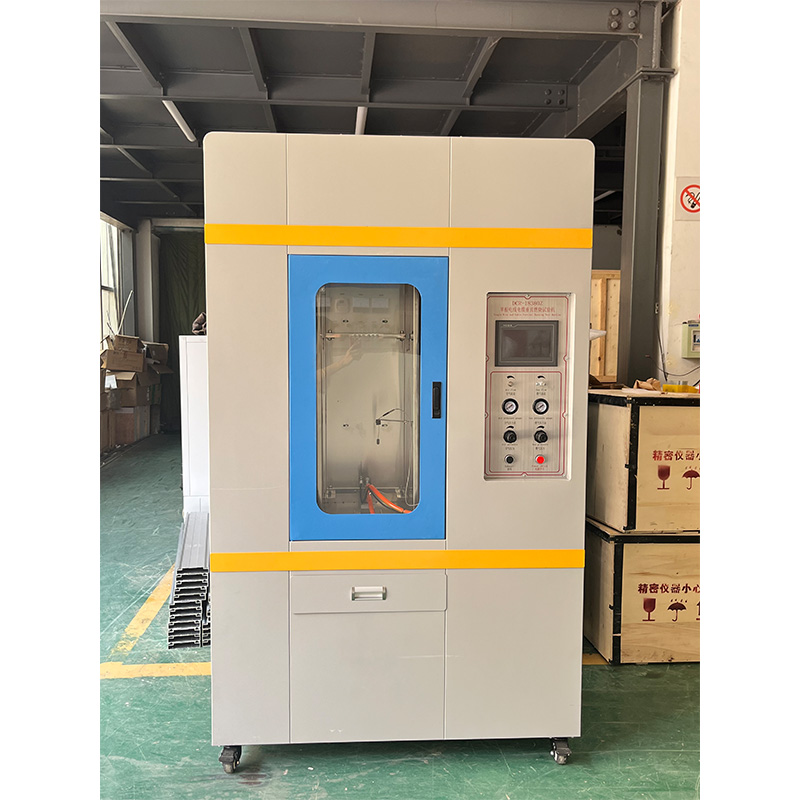
Trustworthiness and Support: Your Partner in Fire Safety Testing
Our commitment extends beyond providing cutting-edge equipment; we strive to be a reliable partner, ensuring our clients receive unparalleled support and peace of mind throughout the lifespan of their DCR-18380Z Single Wire and Cable Vertical Burning Tester.
Frequently Asked Questions (FAQ):
-
Q1: What specific international standards does the DCR-18380Z comply with?
A1: The DCR-18380Z is designed and tested to comply with IEC 60332-1-2, GB/T 18380.11, VDE 0482-332-1-2, relevant sections of UL 1581, and ISO 17846, among others. A detailed list is available upon request. -
Q2: How often does the DCR-18380Z require calibration?
A2: We recommend annual calibration by certified technicians to ensure continued accuracy and compliance. Burner calibration (e.g., flame height and temperature) should be checked regularly as per the specific test standard. -
Q3: What are the primary safety features integrated into the DCR-18380Z?
A3: Key safety features include automatic gas shut-off on power loss or emergency stop activation, an integrated exhaust system with interlock, a prominent emergency stop button, and an optional flame monitoring sensor for enhanced safety. -
Q4: Can the DCR-18380Z be integrated into existing lab automation systems?
A4: Yes, the DCR-18380Z features data export capabilities via USB, and with custom software development, it can be integrated into Laboratory Information Management Systems (LIMS) or other automation platforms. -
Q5: What type of gas is required for operation?
A5: The tester primarily uses industrial-grade Propane or Methane (LPG with specified purity levels), controlled by a precision mass flow controller.
Lead Time and Fulfillment:
Our standard lead time for the DCR-18380Z Single Wire and Cable Vertical Burning Tester typically ranges from 4-8 weeks, depending on current production schedules and any requested customizations. We maintain robust global logistics channels, ensuring efficient and secure delivery to clients worldwide. Expedited shipping options are available for urgent requirements.
Warranty Commitments:
Each DCR-18380Z unit comes with a comprehensive 12-month warranty covering manufacturing defects and component failures under normal operating conditions. Extended warranty options are available for clients seeking prolonged coverage and peace of mind.
Customer Support and After-Sales Service:
We pride ourselves on exceptional customer service. Our dedicated support team offers:
- Technical Assistance: Prompt response to technical inquiries and troubleshooting support via phone, email, or remote diagnostics.
- Spare Parts Availability: A readily available inventory of genuine spare parts to minimize downtime.
- Installation & Training: On-site or remote installation guidance and comprehensive operational training for laboratory personnel.
- Preventive Maintenance Programs: Tailored service contracts to ensure optimal performance and longevity of your equipment.
Authoritative References and Citations
The information presented herein is underpinned by established industry standards and scientific principles related to fire safety testing of wires and cables. Key authoritative sources include:
- International Electrotechnical Commission (IEC) Standard 60332-1-2: Tests on electric and optical fibre cables under fire conditions – Part 1-2: Test for vertical flame propagation for a single insulated wire or cable – Procedure for 1 kW pre-mixed flame.
- Underwriters Laboratories (UL) Standard 1581: Reference Standard for Electrical Wires, Cables, and Flexible Cords.
- International Organization for Standardization (ISO) Standard 17846: Reaction to fire tests for products — Determination of heat of combustion of materials by oxygen bomb calorimeter method.
- National Fire Protection Association (NFPA) 70: National Electrical Code (NEC) – Articles pertaining to wiring methods and materials fire resistance.
- European Committee for Electrotechnical Standardization (CENELEC) Standard EN 50265-2-1: Common test methods for cables under fire conditions – Part 2-1: Test for vertical flame propagation for a single insulated wire or cable – Procedure for 1 kW pre-mixed flame.
-
CX-100 Manual Hydraulic Core Punching Machine - Efficient & Reliable
NewsAug.28,2025
-
Reliable Performance Testing with Advanced Aging Chamber Solutions
NewsAug.23,2025
-
Advancing Precision with Profile Projector Technology
NewsAug.23,2025
-
UV-LED Ultraviolet Crosslinking Technology: Innovation and Prospects
NewsAug.23,2025
-
Ensuring Safety and Compliance
NewsAug.23,2025
-
Electrical Properties Testing in Modern Applications
NewsAug.23,2025
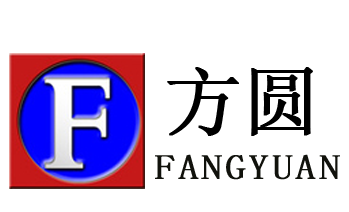 Copyright © 2025 Hebei Fangyuan Instrument & Equipment Co.,Ltd. All Rights Reserved. Sitemap | Privacy Policy
Copyright © 2025 Hebei Fangyuan Instrument & Equipment Co.,Ltd. All Rights Reserved. Sitemap | Privacy Policy

